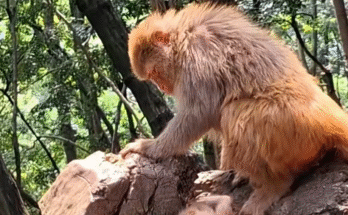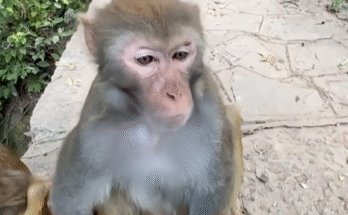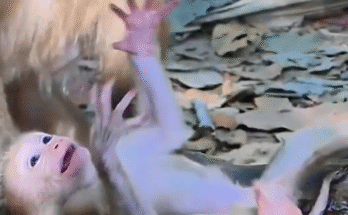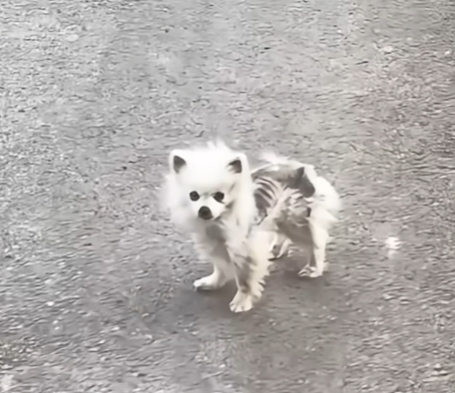
We first saw him on the edge of a dusty, forgotten alleyway, a lone figure moving slowly, hesitantly, as if the weight of the world rested upon his tiny frame. At first, we barely recognized him as a living creature. His ribs protruded sharply beneath his dull, matted fur, each step a struggle. His spine jutted unnaturally, hips jutting out at odd angles, and every movement seemed to cost him an unimaginable amount of effort. He was painfully thin—skin and bones, reduced to nothing but the bare outline of what should have been a healthy, strong body.
He was a dog, no more than three years old, yet the years of neglect and suffering had aged him far beyond his time. His fur hung in clumps, tangled and filthy, with patches missing from repeated scratching and untreated infections. Dirt and dried mud crusted his paws and muzzle. His eyes, once perhaps bright and curious, now glistened with a dull, haunting emptiness. They told the story of a life filled with hunger, fear, and loneliness—of nights spent cold and alone, and days spent searching desperately for a morsel of food or a place to rest.
He noticed us almost instantly. There was no hesitation, no caution. Only desperation in his movements and a weak, pitiful whine that tore at our hearts. He staggered toward us, tail low and limp, ears back. His gaze met ours, not with trust, but with a cautious hope born of sheer need. He didn’t seem to expect kindness—he had long ago stopped believing in it—but somewhere deep down, he recognized that something might finally change.
The first approach was tentative. We knelt slowly, speaking softly, letting him sniff our hands. He recoiled slightly, not out of aggression, but out of instinct: years of neglect had taught him that humans often brought pain instead of comfort. Yet his hunger for safety overcame his fear. Inch by inch, he allowed us to draw closer, until finally, we could gently guide him into a carrier for the trip to the veterinary clinic.
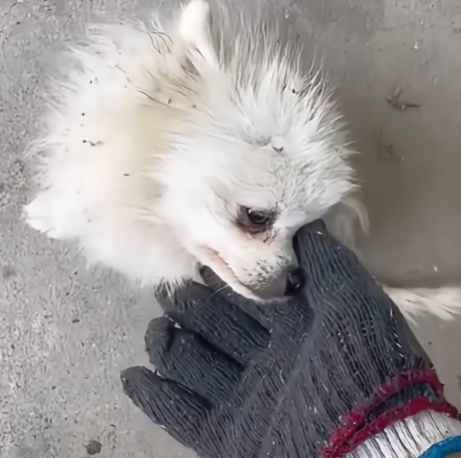
Every step was a challenge. His legs trembled under his fragile body; his paws scraped against the pavement as if each contact burned him. And yet he kept moving, driven by the faintest spark of hope that maybe, just maybe, things could get better.
At the clinic, the extent of his suffering became heartbreakingly clear. He was severely malnourished, dehydrated, and infested with parasites. His body was weak, his muscles had wasted away, and his fur clung to his skin in heavy mats that trapped dirt and moisture. Several open sores had formed where infection had set in, and his gums were pale, a sign of anemia. The veterinarian shook their head solemnly. “He’s in terrible shape,” they said. “We can try, but it’s going to be a long road.”
We weren’t discouraged. Every inch of him radiated resilience—a will to survive that hadn’t been crushed by his hardships. We set to work immediately. IV fluids were administered to combat dehydration, medications to fight infection and parasites, and a carefully measured feeding plan was established to restore nutrition without overwhelming his fragile system. The matted fur was carefully shaved, revealing the true extent of his emaciated body. It was painful to see, but necessary to prevent further skin infections and allow him to heal.
The first few days were the hardest. He was weak, trembling constantly, barely able to stand. He ate only tiny amounts, often pausing between bites, unsure if he could trust the food or the hands that offered it. He would lie curled up in a corner of his bed, exhausted by the simplest movements, yet still alert to our presence. He flinched at sudden noises, avoided sudden movements, and sometimes whimpered quietly as though haunted by the past.
But slowly, ever so slowly, change began to show. After the first week, he could lift his head without wobbling. His breathing became steadier. His legs, once so weak and frail, supported him for longer stretches as he began to walk around the recovery room. He started eating more consistently, lapping up the food we provided with a voracious but careful determination. And in those small, seemingly insignificant moments, we began to see life returning to him.
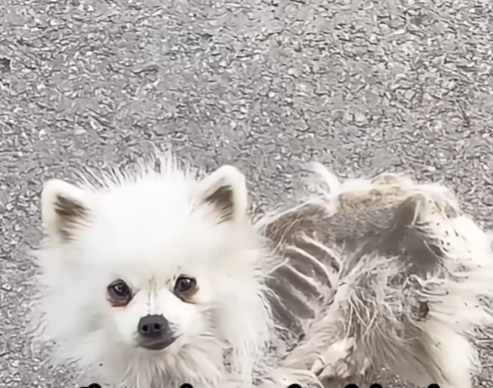
The second week brought more dramatic improvements. His coat, now free of matted tangles, began to shine faintly in patches, and his skin started to regain a healthy tone. The sores on his body began to heal, and the medications took effect, reducing swelling and discomfort. Most importantly, his eyes began to sparkle again. Where there had been emptiness and fear, there was now curiosity and cautious optimism. He followed our movements around the room, wagging his tail slightly when we approached—small gestures, but monumental in the context of his suffering.
It was during this time that we realized just how remarkable he was. Despite all he had endured—starvation, abandonment, neglect—he retained a gentle, patient spirit. He was never aggressive. He never lashed out. Instead, he offered a quiet trust, a willingness to accept care and love, even when he had no reason to believe in it.
As the weeks passed, he gained weight, his muscles began to strengthen, and his movements became more fluid. Where once he had staggered with every step, he now walked with a cautious confidence, exploring his surroundings with curiosity rather than fear. He would approach us willingly for petting, leaning into our hands and allowing us to brush his fur. He learned to play gently with toys, wag his tail in excitement, and even bark softly when he wanted attention.
The transformation was not just physical. His spirit, long buried under layers of neglect and suffering, emerged stronger than ever. He learned to trust, to love, and to enjoy the simple pleasures of life—a warm bed, nutritious meals, and the gentle company of those who cared for him. He began to greet each day with a sense of anticipation rather than dread, and his once sunken eyes now shone with vitality.
One particularly memorable day, we took him outside for the first time in months. The sun warmed his fur, and the soft breeze carried scents he had not experienced in a long time. He paused, lifted his nose, and inhaled deeply, closing his eyes for a moment in pure contentment. Then he ran, slowly at first, testing his legs, and then faster, until he was bounding across the yard with joy. The sight was overwhelming—this dog, once reduced to skin and bones, wandering in utter misery, now running freely, full of life and hope.
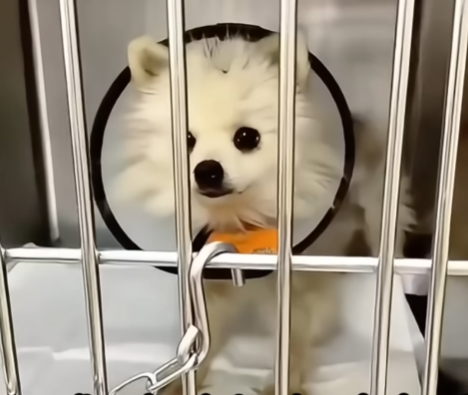
Months after that first rescue, he had fully recovered. He had gained a healthy weight, his muscles were strong, and his coat gleamed. More importantly, his heart had healed. He had formed a bond with us, trusting completely, and showing affection in ways that reminded us why we do this work. He loved attention, cuddled against us in the evenings, and greeted visitors with a gentle, welcoming demeanor.
His story became an inspiration—not just for the people who rescued him, but for everyone who heard about him. He was a testament to resilience, the power of compassion, and the importance of never giving up on a life that seemed beyond saving. From skin and bones, wandering in misery, he had emerged strong, healthy, and full of love, proving that hope can flourish even in the darkest of circumstances.
Rescuing him was not easy. There were moments of doubt, fear, and heartbreak. But each step forward, each small victory, reminded us that every life matters. His journey from despair to joy showed that with patience, care, and unwavering commitment, transformation is possible.
Now, when we look at him, we see a dog who embodies hope. He runs, plays, sleeps peacefully, and loves without reservation. He is no longer a shadow wandering the streets—he is a beacon of resilience and a living reminder that even the most broken souls can heal.
This is more than a story about a rescued dog. It is a story about compassion, determination, and the transformative power of love. It is proof that no matter how dire a situation may seem, there is always a chance for renewal, and every life, no matter how battered, deserves to be saved.
From misery and starvation to joy and vitality, he is living proof that hope, when nurtured, can triumph over suffering, and that even the most fragile among us can rise again to find happiness.
